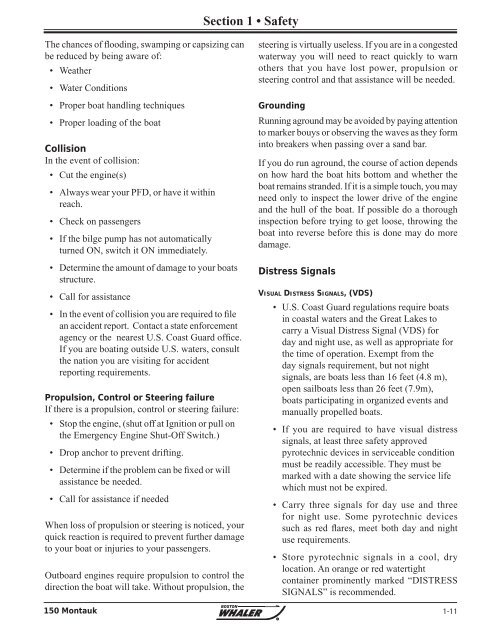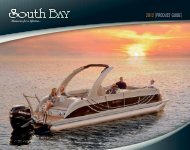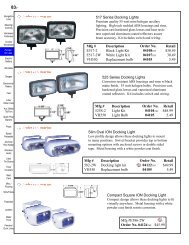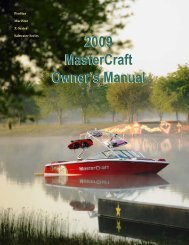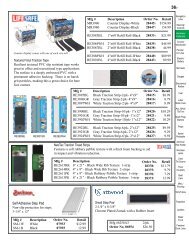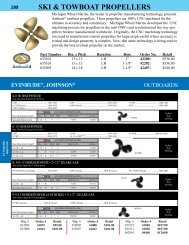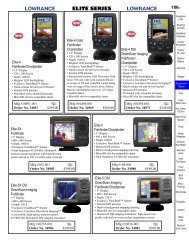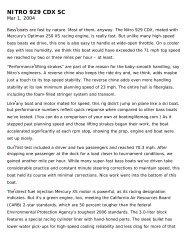notice - Boston Whaler
notice - Boston Whaler
notice - Boston Whaler
You also want an ePaper? Increase the reach of your titles
YUMPU automatically turns print PDFs into web optimized ePapers that Google loves.
The chances of fl ooding, swamping or capsizing can<br />
be reduced by being aware of:<br />
• Weather<br />
• Water Conditions<br />
• Proper boat handling techniques<br />
• Proper loading of the boat<br />
Collision<br />
In the event of collision:<br />
• Cut the engine(s)<br />
• Always wear your PFD, or have it within<br />
reach.<br />
• Check on passengers<br />
• If the bilge pump has not automatically<br />
turned ON, switch it ON immediately.<br />
• Determine the amount of damage to your boats<br />
structure.<br />
• Call for assistance<br />
• In the event of collision you are required to fi le<br />
an accident report. Contact a state enforcement<br />
agency or the nearest U.S. Coast Guard offi ce.<br />
If you are boating outside U.S. waters, consult<br />
the nation you are visiting for accident<br />
reporting requirements.<br />
Propulsion, Control or Steering failure<br />
If there is a propulsion, control or steering failure:<br />
• Stop the engine, (shut off at Ignition or pull on<br />
the Emergency Engine Shut-Off Switch.)<br />
• Drop anchor to prevent drifting.<br />
• Determine if the problem can be fi xed or will<br />
assistance be needed.<br />
• Call for assistance if needed<br />
When loss of propulsion or steering is <strong>notice</strong>d, your<br />
quick reaction is required to prevent further damage<br />
to your boat or injuries to your passengers.<br />
Outboard engines require propulsion to control the<br />
direction the boat will take. Without propulsion, the<br />
150 Montauk<br />
Section 1 • Safety<br />
steering is virtually useless. If you are in a congested<br />
waterway you will need to react quickly to warn<br />
others that you have lost power, propulsion or<br />
steering control and that assistance will be needed.<br />
Grounding<br />
Running aground may be avoided by paying attention<br />
to marker bouys or observing the waves as they form<br />
into breakers when passing over a sand bar.<br />
If you do run aground, the course of action depends<br />
on how hard the boat hits bottom and whether the<br />
boat remains stranded. If it is a simple touch, you may<br />
need only to inspect the lower drive of the engine<br />
and the hull of the boat. If possible do a thorough<br />
inspection before trying to get loose, throwing the<br />
boat into reverse before this is done may do more<br />
damage.<br />
Distress Signals<br />
VISUAL DISTRESS SIGNALS, (VDS)<br />
• U.S. Coast Guard regulations require boats<br />
in coastal waters and the Great Lakes to<br />
carry a Visual Distress Signal (VDS) for<br />
day and night use, as well as appropriate for<br />
the time of operation. Exempt from the<br />
day signals requirement, but not night<br />
signals, are boats less than 16 feet (4.8 m),<br />
open sailboats less than 26 feet (7.9m),<br />
boats participating in organized events and<br />
manually propelled boats.<br />
• If you are required to have visual distress<br />
signals, at least three safety approved<br />
pyrotechnic devices in serviceable condition<br />
must be readily accessible. They must be<br />
marked with a date showing the service life<br />
which must not be expired.<br />
• Carry three signals for day use and three<br />
for night use. Some pyrotechnic devices<br />
such as red fl ares, meet both day and night<br />
use requirements.<br />
• Store pyrotechnic signals in a cool, dry<br />
location. An orange or red watertight<br />
container prominently marked “DISTRESS<br />
SIGNALS” is recommended.<br />
R<br />
1-11


